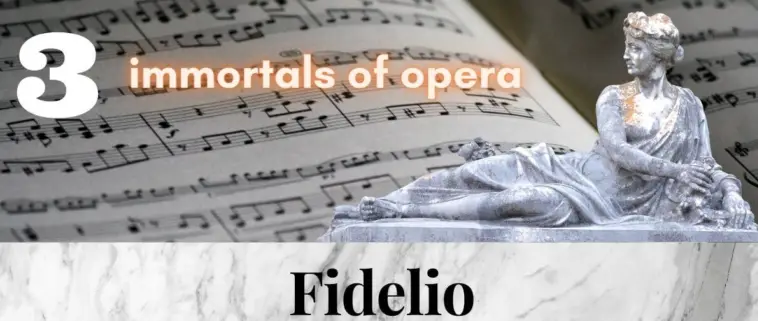Few works occupied Beethoven as persistently as his only opera. It was not until the third version that it reached its definitive version. Beethoven created scenes that went down in opera history and still touch us today with their power and truthfulness.
The quartet “Mir ist so wunderbar”
Without Leonore’s entrance aria, the dialogue passes into the grandiose quartet “Mir ist so wunderbar”, which may justifiably be counted among the great quartets of opera literature. It captivates not only by its wonderful music, it touches because Beethoven wrote a melody for all of them, which underline the different feelings of the characters; Leonore worries about her incarcerated husband, Marzelline sings of her love for Fidelio, Joaquino laments the loss of Marzelline’s love, and the father is moved by the joy of Fidelio and Marzelline’s coming marriage. Accompanied by a restrained orchestra, the singers join in canon-like and the piece becomes a perfect chamber music quartet.
The version from the 1953 live recording with Furtwängler is one of the great recordings of Fidelio. According to noted German critic Joachim Kaiser, “If one hears from Wilhelm Furtwängler’s 1953 Fidelio recording the quartet of the first act, the extinguishing of the prisoners’ chorus, the duet between Leonore and Rocco, the outrageous beginning of the second act, and the devastatingly dramatic quartet of the second act, then one understands what greatness is.” (Kaiser, “100 Masterpieces of Music”).
Mir ist so wunderbar- Jurinac / Mödl / Frick / Schock / Furtwängler.
“Abscheulicher !… Komm, Hoffnung!”
The great aria of Leonore consists of three parts: Recitative, Cavatina, Cabaletta. In this form Leonore’s basic emotions are described – indignation, hope, ecstasy. The music Beethoven wrote for it unfolds an expressivity through its shattering and at the same time touching expression. It is a seven-minute par force performance by the singer, requiring both the highest dramatic expressivity and the most heartfelt lyricism. Possibly this aria was inspired by Mozart’s “Per pietà ben mio” from “Cosi fan tutte,” which also begins with an adagio introduction, is written in the same key, and also features a concise horn accompaniment.
What did Christa Ludwig think about your interpretation of Leonore: “I couldn’t sing Fidelio in a highly dramatic way, but I played the weak woman trying to save her husband.” For Christa Ludwig, this role was a great challenge. For she was not a highly dramatic soprano. She confessed in an interview about the Leonoren aria: “At the end of the aria, I was always happy as punch when I had managed that note, that high B. After every “Fidelio” performance, I was hoarse. It always took three days before I could use the voice again.” (Source: FAZ)
Abscheulicher !… Komm Hoffnung – Ludwig
The Prisoners’ Chorus
In the Prisoners’ Chorus, we already hear the idyll of the Pastorale that Beethoven will compose just two years later. It is a stroke of genius that Beethoven composed the hope of the prisoners with such heartfelt music. No wonder Verdi felt inspired to compose a second famous prisoners’ chorus forty years later.
O welche Lust (Prisoners’ Chorus) – Bernstein.







Leave a Reply
Want to join the discussion?Feel free to contribute!